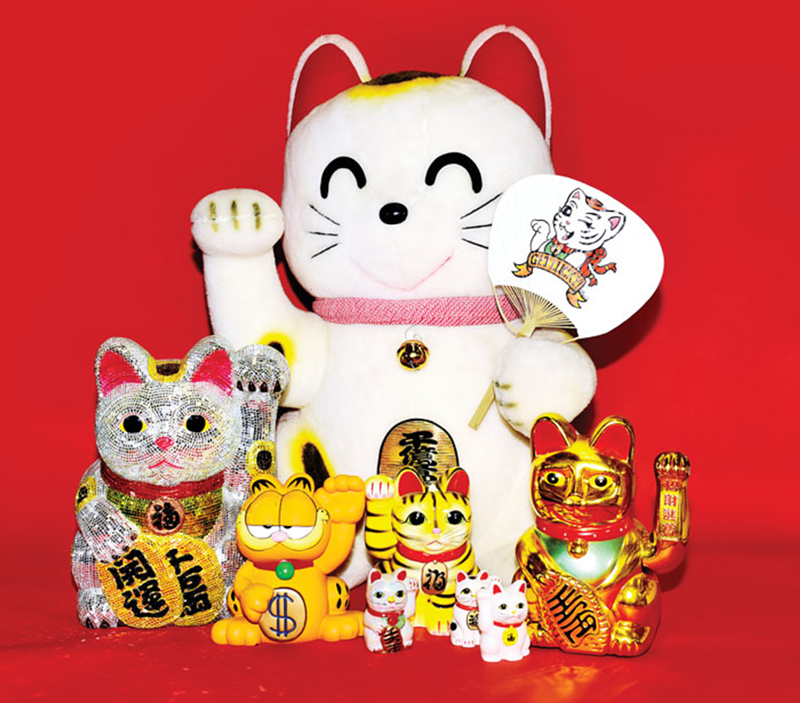There are some people who love cats, and then there are those who really love cats, to the point of opening a niche museum full of them. Micha Robertson opened the Maneki Neko Museum inside Walnut Hills’ Essex Studios three years ago, but she started collecting the Japanese “beckoning” or “lucky” cats a decade ago.
“I was collecting cat stuff, and then I got a couple of lucky cats, and then got a couple more, and it kind of escalated,” she says. She now has more than 800 cats on display (with more on the way), and if she breaks a thousand, she’ll qualify for the Guinness Book of World Records for the most maneki neko cats in a public display.
Maneki nekos are those cats you see in restaurants and shops with one paw raised. If the left paw is raised, money will be summoned to you; if the right paw is raised, good fortune will be bestowed upon you. In Japan, people wave the opposite of Americans, so what we would interpret as waving goodbye here is actually beckoning, or welcoming, in Japan.
Robertson says she’s “owned by five real cats,” and she’s loved felines since her youth in Oklahoma (she and her husband moved to Cincinnati in 2001). She even drives what she dubs the “kitten car,” a 1997 Suzuki X-90 that she and her dad painted to resemble a cat, with brown stripes and kitten face — the headlights even look like cat eyes.
When you walk into her tiny artist space inside Essex (about the size of a studio apartment), you’re greeted by multiple well-organized glass display cases featuring perfectly lined-up cats. The cats come in a score of designs, from the realistic-looking to a more ubiquitous design. A common lucky cat color combo — a white cat with red ears, green bib and red collar with a coin on it — started production in the 1950s in Tokoname, one of Japan’s pottery-centric cities; “Tokonyan,” an 11-foot white maneki neko sculpture, even watches over the town.
Robertson is also an artist, and on display is a maneki neko of her making, covered in mirrors like a mirrorball. Others are for sale in her gift shop (yes, you too can become a collector). Robertson has yet to visit Japan — “Oh, it’s going to be bad when I go,” she says — but what attracts her to the Japanese culture is, of course, their love of cats and their humor.
“They do a lot of pun-based stuff and I’m big into puns,” she says. “And with the lucky cats themselves, it’s a basic idea: raised paw, and it’s interpreted in so many ways and they can be so drastically different from each other. It just fascinates me.”
In her collection are interactive maneki nekos that play music, and a slot machine in which maneki nekos light up. There’s a Winnie the Pooh version, a Hello Kitty one, phones shaped like maneki nekos, Garbage Pail maneki nekos designed by L.A. artist Joe Suzuki, porcelain maneki nekos, sake cup maneki nekos from 1922, a Godzilla maneki neko, a skeleton, a Garfield, a Tama cat maneki neko, a giant inflatable maneki neko, a rare maneki neko from Kustom Kulture artist Makoto Kobayashi, little ones, big ones. You get the idea.
“The weirder they are, the more I love them,” Robertson says. Luckily for her, many of the cats don’t cost much, and she finds a lot of her pieces from eBay, the Goodwill and a Japanese eBay site called Yahoo Japan Auctions.
Because of the lack of air conditioning and heating in the building, the museum is currently only open by appointment and during the Essex Studios Art Walks (the next one is Oct. 2-3), but eventually Robertson would like to host art shows there, especially those centered around cats.
“The biggest part is being able to share the artists with other people,” Robertson says. “The Internet has definitely helped, but people in the U.S., once they see the (maneki neko) artists’ stuff, they fall in love with them, but if not for here they might never know about them.”The museum is not a nonprofit and Robertson pays the rent with donations and gift shop sales, but she needs a more sustainable model — maybe a cat benefactor? The cats need to beckon harder.
So far, she’s had a few people come from out of state to visit the museum, but she’d like more people to know about the museum, including the two other museums in Japan: Manekineko Museum of Art in Okayama and the Maneki-Neko Museum in Seto. The Cat Fanciers’ Association Feline Historical Museum in Alliance, Ohio, has a small section of lucky cats on display, but besides that Robertson’s cats are one-of-a-kind in the U.S.
“I think kittens are the answers to all the world’s issues,” Robertson says. And with that attitude, the cats should bring her and anyone who visits the museum a lot of luck.
The MANEKI NEKO MUSEUM is located at 2511 Essex Place, Walnut Hills. For more info or to book an appointment, visit facebook.com/luckycatmuseum.


